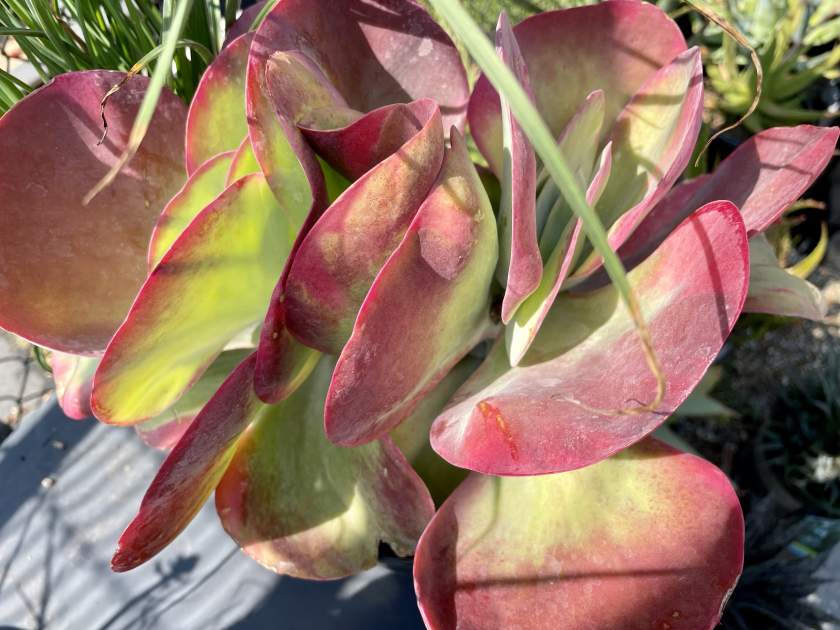Paddle Plant or Kalanchoe luciae: A Stunning Succulent with Striking Foliage and Tubular Flowers
Kalanchoe luciae, commonly known as Paddle Plant, Flapjacks, Red Pancakes, or Desert Cabbage, belongs to the Crassulaceae family, which is widely known as the Stonecrop family. It is native to South Africa. The name “Kalanchoe” has uncertain origins, with some theories suggesting it originated from a phonetic transcription of Chinese words meaning “that which falls and grows,” alluding to the plantlets that drop and develop into new plants. Another theory relates it to the ancient Indian words “kalanka” meaning “spot” or “rust,” and “chaya” meaning “glossy,” referring to the glossy reddish leaves of the Indian species K. laciniata. The specific epithet “luciae” is thought to either honor Mademoiselle Lucy Dufour, an acquaintance of French botanist Raymond Hamet, who described this species, or it could be named after the region of Saint Lucia Park in South Africa, where the plant is endemic.
Characteristics of Leaves and Flowers:
Kalanchoe luciae, also known as Paddle Plant, captivates with its distinct foliage and graceful flowers. Let’s explore its notable features:
Leaves: This succulent showcases a basal rosette of thick, fleshy leaves that resemble clamshells. The leaves are jade green, approximately 8 inches long and 6-8 inches wide, and have a unique gray bloom covering. During the cooler winter months, if grown in bright light, the leaf tips transform into vibrant red-wine hues, adding a striking contrast to the overall appearance.
Flowers: In late winter to early spring, Kalanchoe luciae produces a tall, sturdy stem reaching 2-3 feet in height. Atop this stem, clusters of delicate pale yellow tubular flowers emerge, adding an elegant touch to the plant. The flowers attract pollinators such as bees, contributing to the biodiversity of your garden.
Fragrance: While Kalanchoe luciae is not known for its fragrance, it enchants its visual appeal.
Cultivation of Kalanchoe luciae:
Sunlight: Paddle Plant thrives in both full sun and light shade. It can tolerate direct sunlight, but providing some shade during intense midday heat is beneficial for its optimal growth and leaf coloration.
Watering: This succulent prefers dry to medium moisture levels and well-drained soils. Allow the soil to dry out before watering again, otherwise, this can lead to root rot. During the dormant winter period, reduce watering frequency.
Soil: Well-drained soil is crucial for the health of Kalanchoe luciae. It can adapt to various soil types, including sandy, loamy, or rocky soils. Adequate soil drainage is critical to prevent waterlogging.
Pest and Disease Management: Kalanchoe luciae is generally resistant to pests and diseases. However, it can be susceptible to damage from slugs and snails, which may disfigure the leaves. Implement appropriate pest control measures such as organic slug repellents or physical barriers to protect the plant.
Propagation:
Paddle Plant can be propagated through stem cuttings. Follow these steps to propagate Kalanchoe luciae:
- Select a healthy stem cutting, approximately 4-6 inches in length.
- Remove the lower leaves, leaving a bare stem.
- Let the cutting dry and callus over for a couple of days.
- Plant the cutting in well-draining soil or a suitable propagation mix.
- Provide bright but indirect light.
- Water the cutting lightly, ensuring the soil remains slightly moist but not overly wet.
- After a few weeks, the cutting should develop roots and establish itself as a new plant.
- Transplant the rooted cutting into a larger pot or garden bed, providing it with suitable growing conditions.
Winter Care: Kalanchoe luciae is not frost-tolerant and cannot withstand freezing temperatures. It is best to protect it from frost or bring it indoors during the winter months if you live in a colder climate.
Additional Tips for Kalanchoe luciae Care:
- Paddle Plant is an excellent choice for coastal gardens, succulent gardens, Mediterranean gardens, or even as a striking container plant.
- Native to South Africa, Kalanchoe luciae thrives in arid and semi-arid climates and can be a valuable addition to xeriscapes or water-wise landscapes.
Explore the Beauty of Paddle Plant (Kalanchoe luciae) – A Mesmerizing Succulent with Unique Foliage and Graceful Flowers
Embrace the captivating allure of Kalanchoe luciae, with its distinctive foliage and elegant flowering spikes, to create stunning visual compositions in your garden.




